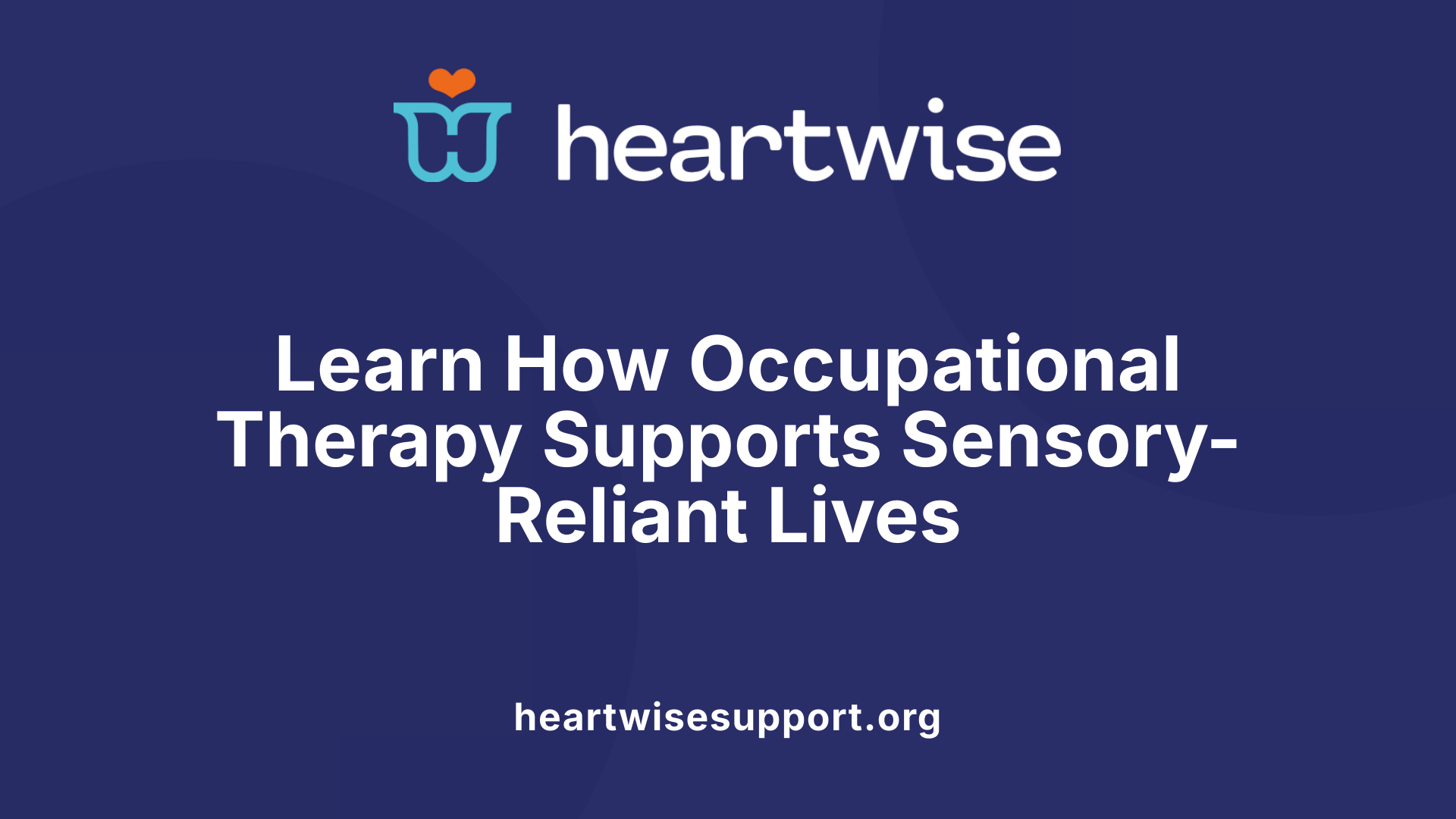Understanding the Foundations of Sensory Modulation in Occupational Therapy
Sensory modulation is a vital component of occupational therapy that helps individuals manage their responses to sensory stimuli, promoting adaptive behaviors and improved participation in daily life. Rooted in neurophysiological principles and leveraging a range of assessment tools and intervention strategies, occupational therapists design personalized approaches to address sensory processing challenges across diverse populations.
Approaches and Techniques in Sensory Modulation

What are the approaches used in sensory modulation within occupational therapy?
Sensory modulation in occupational therapy is a comprehensive process that involves various methods aimed at helping individuals manage their reactions to sensory stimuli. The main goal is to improve their capacity for self-regulation, enabling better engagement in daily activities and social participation.
One of the foundational steps is assessment. Occupational therapists often utilize tools like the Sensory Profile, including the Infant & Child Sensory Profile and the Adolescent/Adult Sensory Profile, to identify each person’s unique sensory processing patterns. These assessments help in pinpointing sensitivities, preferences, and areas needing intervention.
Based on assessment findings, therapists develop personalized sensory diets—structured plans that incorporate specific activities to provide the right type and amount of sensory input at appropriate times. These can include proprioceptive activities like weighted blankets or and resistive exercises, vestibular movements such as swinging or jumping, and tactile experiences like textured exploration.
Environmental modifications are decisive strategies, tailored to reduce sensory overload or under-responsiveness. Adjustments might include creating calm spaces, dimming lights, reducing noise, and using sensory-friendly seating arrangements. These modifications foster a conducive environment for regulation.
Grounding and calming techniques form another vital approach. These are practical activities designed to help individuals regain focus and calmness when overwhelmed. Examples include deep pressure activities like holding a weighted item, deep breathing exercises, or engaging in activities that connect their body to their environment.
Specialized interventions further enrich sensory modulation strategies. Techniques like the Wilbarger Deep Pressure and Proprioceptive Technique (DPPT) involve brushing the skin with a specific protocol combined with joint compressions. These are aimed at stimulating tactile and proprioceptive systems to facilitate nervous system regulation.
Another significant method is the Oral Tactile Technique (OTT), which involves activities that stimulate oral sensory input, such as different tastes and textures, to improve sensory discrimination.
Overall, sensory modulation strategies are person-centered and trauma-informed, emphasizing individual preferences, environmental context, and the development of resilience. These approaches are not only therapeutic but also empower individuals to develop greater self-awareness, cope with triggers effectively, and participate actively in their community and daily lives.
Sensory Processing and Modulation: Core Concepts in OT

What is sensory processing and modulation in occupational therapy?
Sensory processing refers to the way individuals perceive, organize, and respond to sensory input from their environment. This includes stimuli related to touch, sound, movement, sight, taste, and proprioception—the sense of how our body parts are positioned in space. Efficient sensory processing allows us to interpret these signals accurately and react appropriately.
Sensory modulation is a fundamental part of sensory processing. It focuses on helping individuals regulate their responses to sensory stimuli, preventing over- or under-reactivity. Over-responsiveness can manifest as hypersensitivity—being easily overwhelmed by sounds, textures, or lights—while under-responsiveness may involve a lack of reaction to stimuli, leading to risk-taking behaviors or difficulty paying attention.
Occupational therapy emphasizes tailored interventions for these challenges. One of the main approaches is sensory integration therapy (SIT). This therapy involves engaging individuals—most often children—in activities that stimulate various sensory systems such as vestibular (movement and balance), proprioceptive (body awareness), and tactile (touch). For example, bouncing on a therapy ball, swinging, brushing the skin, or exploring textured objects.
The goal of these activities is to improve the brain's capacity to process and organize sensory information effectively. As a result, individuals develop better self-regulation, enhanced behavioral responses, and increased participation in daily life.
Occupational therapists assess individual sensory needs using tools like sensory profiles and inventories. Based on this assessment, they create personalized programs—often involving sensory diets—that incorporate specific activities at appropriate times and environments.
Ultimately, interventions aim to support individuals in achieving a balanced nervous system, enabling more adaptive responses during social, educational, and everyday situations. By enhancing sensory integration, occupational therapy helps individuals lead more comfortable, engaged, and functional lives.
Activities and Techniques for Sensory Modulation
What are some examples of sensory modulation activities and techniques?
Sensory modulation activities and techniques are essential tools used to help individuals maintain a balanced arousal level and regulate their responses to sensory stimuli. These strategies contribute to improved self-awareness and emotional stability.
One common set of activities involves calming methods, such as deep pressure touch. Techniques like using weighted blankets, weighted vests, and tight-fitting clothing can provide a calming input by applying gentle, firm pressure to the body. This deep pressure stimulates the nervous system in a soothing way, helping reduce anxiety and agitation.
Tactile activities also play a vital role. Squeezing stress balls, exploring textured materials like sand or fabric, and engaging with sensory bins filled with various textures help improve tactile discrimination and offer sensory input that can be both calming and alerting.
Another effective approach is the use of sensory diets—a personalized schedule of activities designed to meet an individual's specific sensory needs. For example, a sensory diet might include bouncing on a therapy ball, swinging, or jumping to excite and activate sensory systems, or calming activities like slow rocking or deep-pressure massage.
Environmental modifications support sensory regulation by creating spaces that minimize overwhelming stimuli and foster calmness. Adjustments such as dimming lights, reducing noise levels, using soundproofing panels, or providing quiet zones help prevent sensory overload.
Tools like fidget toys, textured fabrics, and sensory kits are often used to offer discrete, portable sensory input throughout the day. Fidget spinners, textured brushes, and tactile bins provide accessible means for self-regulation during routines at school or work.
Summary of sensory modulation techniques:
| Technique | Description | Purpose |
|---|---|---|
| Deep pressure | Weighted blankets, vests, massages | Calms and organizes the nervous system |
| Tactile activities | Textured objects, brushing, squeezing | Enhances tactile discrimination, provides calming input |
| Sensory diets | Tailored activity schedules | Meet individual sensory needs, regulate arousal |
| Environmental modifications | Lighting, sound adjustments | Reduce overstimulation |
| Use of tools | Fidget toys, textured materials | Discrete sensory input for self-regulation |
These strategies are adaptable and often combined to suit each person's sensory profile, promoting better engagement and emotional control. They are integral components in the broader framework of sensory modulation programs (SMP) and sensory-based interventions that aim to improve overall well-being and functional participation.
Interventions for Sensory Processing Difficulties in Diverse Populations
What are the common interventions for sensory processing difficulties?
Sensory processing difficulties can affect both children and adults, leading to challenges in daily functioning, social participation, and emotional regulation. To address these issues, a variety of interventions have been developed, focusing on improving sensory integration and self-regulation.
One of the most prominent approaches is sensory integration therapy (SIT). This play-based, engaging therapy involves activities such as swinging, bouncing on balls, spinning, and crashing into cushioned surfaces. These activities are designed to challenge the vestibular, tactile, and proprioceptive systems, helping individuals process sensory information more effectively.
Occupational therapists are central to implementing these strategies. They develop personalized plans often involving sensory diets—a sequence of specific activities tailored to meet individual sensory needs. These can include deep pressure activities, tactile exploration, and movement routines that promote self-regulation.
Environmental modifications play a crucial role in managing sensory input. Creating quiet, sensory-friendly spaces at home and in schools helps reduce overwhelming stimuli. Using tools like weighted blankets, fidget toys, noise-canceling headphones, and textured materials can facilitate sensory regulation and calm states.
Parents, caregivers, and teachers are trained to support these interventions by incorporating routines like sensory breaks during the day. For example, scheduled movement or tactile activities help children and adults regain focus and emotional equilibrium.
Additionally, sensory-based interventions such as massage, the Wilbarger brushing protocol, and visual or auditory filtering techniques are employed to modulate specific sensory sensitivities. These practices help individuals experience less distress from everyday sensory challenges.
The integration of technology, including virtual reality environments and wearable sensors, is an innovative addition to sensory interventions. These tools enable real-time adjustment of sensory input, helping users develop adaptive responses more efficiently.
The comprehensive approach involving sensory diets, environmental modifications, therapeutic play, and caregiver involvement ensures a holistic response to sensory difficulties. Such interventions are adaptable across settings—home, school, workplaces—and tailored to meet personal needs for optimal participation.
Through these evidence-informed strategies, individuals with sensory processing challenges can experience reduced anxiety, improved motor skills, better social interactions, and enhanced overall well-being.
| Intervention Type | Examples | Targeted Sensory System | Additional Notes |
|---|---|---|---|
| Sensory Integration Therapy | Swinging, crashing, spinning, brushing | Vestibular, tactile, proprioceptive | Play-based, involves equipment like swings and therapy balls |
| Sensory Diet | Scheduled movement, tactile activities | Multiple sensory systems | Customized to individual preferences and needs |
| Environmental Modifications | Quiet rooms, dim lighting, sensory tools | All sensory modalities | Designed to reduce sensory overload |
| Sensory Tools and Toys | Fidget toys, weighted blankets, noise-canceling headphones | Tactile, auditory, proprioceptive | Support self-regulation and focus |
| Parent and Caregiver Training | Techniques like Wilbarger brushing protocol | Tactile, proprioceptive | Continues therapy at home, reinforces skills |
How do occupational therapy strategies like sensory diets and therapeutic play support individuals?
Occupational therapy plays a vital role by crafting sensory diets and using therapeutic play to improve sensory processing. Sensory diets incorporate a customized sequence of activities, such as jumping on trampolines, using resistance bands, or engaging in calming tactile play, designed to meet specific sensory needs. These routines help individuals develop self-awareness and regulate their physiological and emotional responses.
Therapeutic play involves engaging activities that naturally incorporate sensory stimulation. Play allows children and adults to participate actively while working on sensory integration goals seamlessly and enjoyably. It encourages exploration and sensory discrimination, fostering adaptive responses.
Parents and caregivers are trained to implement these strategies at home, making them consistent and sustainable. Regular practice of sensory diets combined with play activities results in improved attention, decreased sensory-based behavioral issues, and enhanced social participation.
How can parents and caregivers effectively participate in home-based interventions?
Active involvement of parents and caregivers is essential for maximizing the benefits of sensory interventions. Education on techniques such as deep pressure through massage, the Wilbarger brushing protocol, and the use of weighted objects empowers them to support their loved ones.
Caregivers are encouraged to establish predictable routines, including scheduled sensory breaks, calming activities, and environmental adjustments. Creating sensory-friendly environments at home, like quiet corners with soft lighting and tactile materials, helps individuals self-regulate.
Incorporating practical activities into daily routines—like gardening, baking, or art projects, which involve varied textures and movements—facilitates sensory integration naturally.
Consistent implementation and collaboration with occupational therapists ensure that interventions are safe, effective, and aligned with the individual’s evolving needs. Families that actively participate foster a supportive environment that promotes skill development, emotional well-being, and independence.
Supporting the diverse needs within populations
The interventions described are adaptable for various populations, including children with autism, ADHD, developmental delays, and adults with sensory processing challenges. Tailoring activities to individual sensitivities and preferences maximizes engagement and therapeutic outcomes.
Ultimately, combining professional guidance, environmental strategies, therapeutic activities, and caregiver support creates a comprehensive system that helps individuals improve their sensory regulation, participate fully in daily life, and achieve a better quality of life.
Evidence Supporting Effectiveness of Occupational Therapy in Sensory Modulation
Are there evidence and effectiveness for occupational therapy interventions in sensory modulation?
There is a growing body of evidence supporting the use of various occupational therapy interventions aimed at improving sensory modulation, particularly for children with sensory processing challenges such as autism spectrum disorder (ASD), cerebral palsy, and attention deficit hyperactivity disorder (ADHD). One of the most well-studied approaches is sensory integration therapy (SIT), developed by Dr. A. Jean Ayres, which involves structured, play-based activities designed to help individuals process sensory information more effectively.
Research studies have demonstrated that sensory integration therapy can lead to significant improvements in sensory regulation, motor skills, social functioning, and academic performance. For instance, children undergoing sensory integration interventions have shown enhancements in behaviors related to sensory discrimination, attention, and self-regulation. Meta-analyses and systematic reviews support these observations, indicating moderate to large effect sizes in certain populations, especially when therapy is delivered intensively and with fidelity to established protocols.
In addition to sensory integration, other interventions like massage, weighted vests, and sensory diets have been examined. Massage techniques, such as the Wilbarger brushing protocol, have been associated with benefits like improved sleep, reduced anxiety, and calmer behavior in some children. Weighted vests and similar deep pressure activities are often used to promote calming, although recent research has provided mixed evidence about their specific efficacy, with some studies reporting minimal or no benefit.
Environmental modifications, sensory rooms, and the use of sensory kits are also incorporated in occupational therapy practice to help individuals modulate their responses to sensory stimuli, fostering better participation in daily activities.
However, despite these promising results, the overall quality of the research varies considerably. Many studies face limitations such as small sample sizes, lack of control groups, inconsistent intervention protocols, and subjective outcome measures. Consequently, the evidence base, while supportive of certain therapies, is not sufficiently robust to make definitive claims about their universal effectiveness.
Recent systematic reviews emphasize the need for high-quality randomized controlled trials (RCTs) to better understand which specific interventions work best for whom and under what circumstances. They also highlight the importance of tailoring sensory interventions to individual needs and monitoring outcomes rigorously.
In summary, occupational therapy interventions like sensory integration therapy, massage, and sensory diets have demonstrated benefits in improving aspects such as social skills, attention, sensory responses, and behavioral regulation. Nonetheless, the evidence underscores the need for further rigorous research to establish definitive treatment guidelines and optimize intervention strategies for sensory modulation.
Innovations and Current Trends in Sensory Modulation Therapy

What are the current trends and innovations in occupational therapy for sensory modulation?
Occupational therapy for sensory modulation is rapidly evolving with the incorporation of cutting-edge technologies that enhance treatment precision and personalization. One of the major advancements is the use of virtual reality (VR) and augmented reality (AR). These immersive environments allow therapists to create controlled sensory settings tailored to each individual's needs, facilitating sensory processing, emotional regulation, and social skills, particularly in children with autism spectrum disorder.
Wearable sensors have become a vital part of modern sensory therapy. Devices like heart rate monitors, skin conductance sensors, and muscle tension trackers provide real-time physiological data. This information helps therapists make immediate adjustments during sessions, ensuring the individual receives optimal stimulation without feeling overwhelmed or under-stimulated. Such dynamic feedback improves engagement and outcomes, promoting more effective self-regulation.
Technology-enabled personalized sensory experiences extend beyond traditional interventions. Biofeedback systems, integrating with wearable tech, guide individuals toward recognizing and managing their arousal levels independently. These systems often combine visual or auditory cues to reinforce self-regulatory techniques.
Telehealth applications have broadened the reach of sensory modulation therapy. Remote monitoring and virtual consultations enable individuals to access therapy from their homes or community settings. This not only makes therapy more accessible but also encourages continuity and consistency in sensory strategies, empowering clients to implement techniques independently.
Emerging tools like digital applications and sensory-focused video games are designed to motivate engagement and reinforce sensory processing skills. These tools often include interactive activities that adapt to the user's responsiveness, effectively functioning as digital sensory diets.
Furthermore, neurofeedback and other brain-training modalities are gaining attention for their potential to enhance neural pathways involved in sensory integration. These innovations work by providing feedback on brain activity, helping individuals learn to modulate their responses more effectively.
Overall, these technological developments are transforming occupational therapy by making interventions more personalized, engaging, and accessible. They support a holistic approach that leverages advanced tools and methods to improve sensory regulation, behavioral outcomes, and overall well-being.
| Technology/Method | Description | Benefits & Applications | Additional Details |
|---|---|---|---|
| Virtual Reality (VR) | Creates controlled, customizable sensory environments | Enhances social skills, emotional regulation, sensory processing | Used in therapy for autism, anxiety, and sensory integration |
| Wearable Sensors | Monitor physiological responses in real time | Enables dynamic adjustments during therapy sessions | Devices include heart rate monitors, skin conductance sensors |
| Biofeedback Systems | Provide real-time feedback on neural and physiological data | Supports self-regulation, stress management | Often integrated with VR or mobile apps |
| Telehealth & Remote Monitoring | Facilitate therapy through online platforms | Expands access, promotes independence | Suitable for home-based interventions |
| Digital Applications & Games | Interactive sensory activities tailored to user responses | Increases engagement, reinforces sensory skills | Used as supplemental tools in therapy |
| Neurofeedback & Brain Training | Use brain activity feedback to improve sensory responses | Improve neural flexibility and sensory integration | Still emerging, with ongoing research |
How do these innovations impact current practice?
These technological innovations have made sensory modulation therapy more adaptable and individualized. They allow therapists to deliver interventions aligned precisely with each person’s sensory profile, leading to more tangible progress.
Patients benefit from increased motivation, engagement, and the ability to practice skills in safe, controlled environments outside traditional clinics. Moreover, remote access to therapy reduces barriers such as geographical constraints and transportation issues.
In the future, integration of AI and machine learning may further refine these tools, enabling more sophisticated personalization and predictive analytics to optimize therapy strategies.
The continued evolution of technology in occupational therapy signifies a move toward more holistic, accessible, and effective interventions, promising better outcomes for individuals with sensory processing challenges.
The Future of Sensory Modulation in Occupational Therapy
As occupational therapy continues to evolve, the integration of technology, evidence-based practices, and personalized approaches holds promise for enhancing sensory modulation interventions. Emphasizing functional outcomes and client-centered care, future developments aim to improve quality of life, independence, and social participation for individuals with sensory processing challenges, making sensory modulation a vital and dynamic aspect of therapeutic practice.
References
- The Sensory Modulation Program for Adolescents & Adults
- 8 Sensory Integration Therapy Techniques
- [PDF] Sensory toolkit
- [PDF] Sensory Processing Tips and Strategies - HSE
- Sensory Integration Therapy and its Role in Occupational Therapy
- Sensory modulation interventions for adults with mental illness
- Treating Sensory Processing Issues - Child Mind Institute
- Sensory Integration Frame of Reference - OT Theory
- What is Sensory Modulation in Occupational Therapy - PT Kids
- Innovative Techniques in Sensory Processing Occupational Therapy











